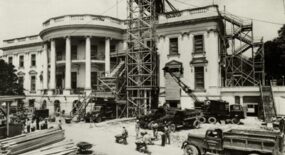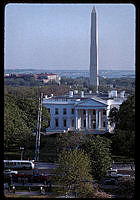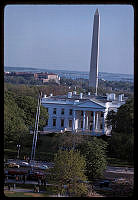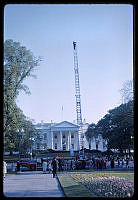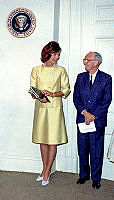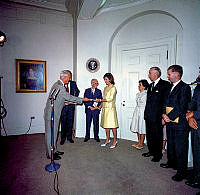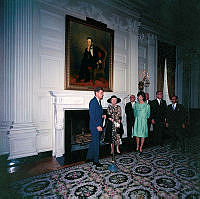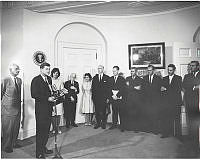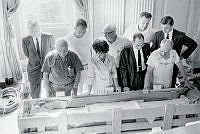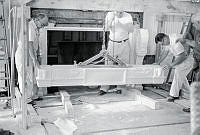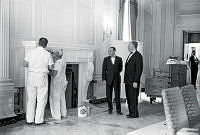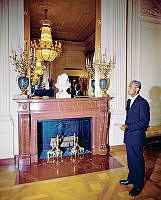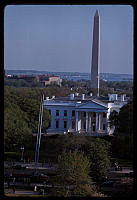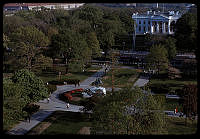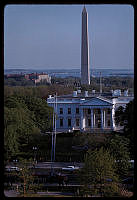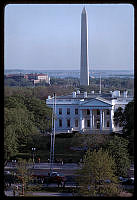Introduction: Where Oh Where Should the Capital Be?
The Seat of the Government in Expanding Nation
Copyright © Fall 2013 White House Historical Association. All rights reserved under international copyright conventions. No part of this article may be reproduced or utilized in any form or by any means, electronic or mechanical, including photocopying, recording, or by any information storage and retrieval system, without permission in writing from the publisher. Requests for reprint permissions should be addressed to books@whha.org
So much about the new United States was new—a democracy in a world full of monarchies, an elected president instead of a king, a people who had claimed the rights and responsibilities of citizens, to name just a few—that it should be no surprise that the location of a capital city would be addressed by the Framers of the U.S. Constitution. The only other capital that was “created” out of nothing was St. Petersburg, and that city came into existence at the command of Czar Peter I as one of his ongoing efforts to Westernize Russia. All other capitals were the seats of royal power and home to the monarch. Government had grown up around the sovereign’s court.
The Framers realized that whatever capital was settled on needed to be a Federal City, not one controlled by a state government. No state should have an advantage over the other states, and the federal government needed to be in charge of its own house. In Article I, Section 8, the Constitution states that Congress shall have the power “to exercise exclusive Legislation in all Cases whatsoever, over such District (not exceeding ten Miles square) as may, by Cession of particular States, and the Acceptance of Congress, become the Seat of the Government of the United States.” Perhaps recognizing that to actually spell out a location would place an early impediment in the establishment of a federal government, the Framers left its site unspecified. The issue was settled when Congress passed the Act for Establishing the Temporary and Permanent Seat of the Government of the United States on July 16, 1790; it was more generally known as the Residence Act.
This piece of legislation was a compromise on two major concerns before Congress. One was a proposal that the federal government would assume the unpaid debts that the states had incurred during the Revolution. Alexander Hamilton believed that such action was necessary to establish the good faith and credit of the federal government so that the United States could take its place among the nations of the world on a sound financial footing. This idea was not wholly agreeable, however, because most southern states had paid their debts and were reluctant to see other states benefit from the national government’s proposal. The other concern was the location of the national capital. Northern states wanted the capital in their part of the country, preferably somewhere in Pennsylvania or New York. In the end southern members of Congress supported the assumption of state debts and northern members supported legislation that would allow President George Washington to select the location of the capital somewhere along an 80-mile stretch of the Potomac River. These two issues foreshadowed the North-South conflicts that would often frustrate the operations of government in the nation’s first seventy years. But for the moment a compromise was reached.

President George Washington was in charge of selecting the location of the capital.
White House Collection/White House Historical AssociationThere was another idea driving the debate over the location of the capital—the idea that it should be “central,” equally accessible to all. By the time of the passage of the Residence Act, three states—Delaware, Virginia, and Georgia—had already moved their capitals to more central locations. In the next twenty years eight more states did so, too. Only Maryland and Massachusetts retained their old colonial capitals.1 In the new states west of the Appalachians, capitals were placed in as central a location as possible. Indiana, in fact, charged its commissioners to select a site at the geographic center of the state.
Once the president announced his selection of a site, January 24, 1791, planning for the new city began. The cornerstone for the White House was laid October 13, 1792, and that for the Capitol, on August 18, 1793. In November 1800, President John Adams moved into the White House, and in the same month the Congress began conducting its business in the unfinished Capitol. The 1800 census showed that 8,144 people lived within the District of Columbia, and that 69 percent of them were white. A considerable number of these persons were residents of Georgetown, an existing Potomac River port within the new Federal District. The next census showed almost a doubling of the population, to 15,471. The city was growing, but it was not yet the national center the early proponents hoped it would be.
The greatest threat to the new capital came in August 1814, when the British army invaded the city and burned the White House and Capitol as well as other government buildings. Although the British were in Washington just two days, the damage, physically and emotionally, was substantial. But Congress was determined to rebuild. Upon their return to Washington, President and Mrs. Madison moved into Colonel John Tayloe’s Octagon House. The reconstruction of the nearby White House was begun almost immediately and was largely completed by the time President James Monroe took the Oath of Office. City leaders and businessmen raised money for a temporary structure to house Congress while reconstruction of the Capitol continued. These actions forestalled any thoughts about relocating the capital. But even at this early date “the Seat of the Government” was no longer truly central.
Although by 1815 the United States was still a nation focused on the Atlantic seaboard, four states west of the Appalachians had been admitted to the union2 and the nation’s territory stretched to the Rocky Mountains. By 1840, new states outnumbered the original thirteen, and by 1860 the country spanned the continent to the Pacific, with two states—California and Oregon—on the Pacific Coast.

Andrew Ellicott’s Territory of Columbia (1793) was the first map of the Federal Territory. Commissioned by President George Washington, it included Pierre L’Enfant’s Plan and, at Washington’s request, the established port of Georgetown. Ellicott also followed Thomas Jefferson’s advice for orienting the map to the north, giving it a pleasing diamond shape when printed. For nearly seventy years Ellicott’s map remained the only official map of the entire “Territory of Columbia.”
In the wake of the Civil War and the Union victory, midwesterners began to clamor for a new capital in a central location. The St. Louis booster and publisher Logan U. Reavis, with energetic support from Horace Greeley, invited delegates to attend a National Capital Removal Convention in St. Louis, on October 26, 1869, that promoted the idea of making that Missouri city the federal capital. After two days, however, the delegates failed to reach consensus on future plans. Press coverage of the convention did serve, however, to bring the idea of relocating the capital to the public’s attention. Another relocation convention was held the next year in Cincinnati. Local boosters attempted without success to convince the delegates that their thriving city was an ideal location.
As these and other proposals initiated a debate about Washington’s future and the location of the capital, newly elected President Ulysses S. Grant, a midwesterner himself, decided that the solution lay in making Washington a capital worthy of the nation whose government resided there. Grant worked with Congress to create a territorial form of government for the District of Columbia. The first governor, Henry D. Cooke (younger brother of financier Jay Cooke and a force in the Ohio Republican Party), appointed Alexander Robey Shepherd to the D.C. Board of Public Works. In short order Shepherd set out to turn Washington into the city that Grant envisioned through a massive public works campaign. Grant regularly pressed Congress to provide “liberal appropriations” to the improvements. Streets were graded and paved, sidewalks laid, sewers and water mains installed, streetcar lines extended, streetlights put in, and thousands of trees planted.3 New office buildings, museums, libraries, and other amenities followed. The city became a capital, and talk of a new location ceased.

A map by Joshua Fry and Peter Jefferson.
The White House Historical Association




